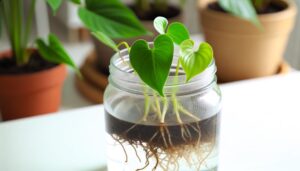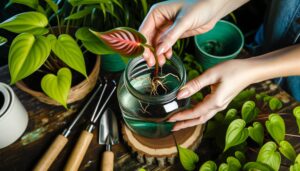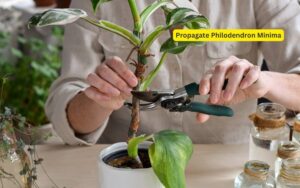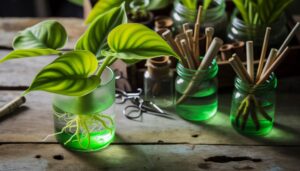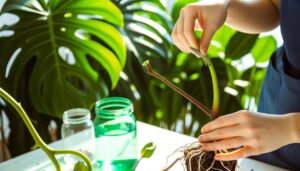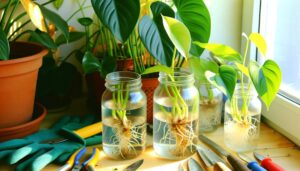How to Propagate Painted Lady Philodendron? Expert Tips!
Propagating a Painted Lady Philodendron requires precision and careful preparation. Begin by gathering sterilized trimming scissors, a clean glass container with water, rooting hormone, and a well-draining soil-filled pot.
Select a healthy parent plant with vibrant, undamaged leaves and a robust root system. Identify a cutting spot on a healthy stem with at least one node and make a clean cut below the node using sanitized scissors.
Allow the cutting to callus before placing it in water or moist soil. Position the cutting in bright, indirect sunlight and maintain high humidity.
Implementing these steps will result in successful propagation efforts.
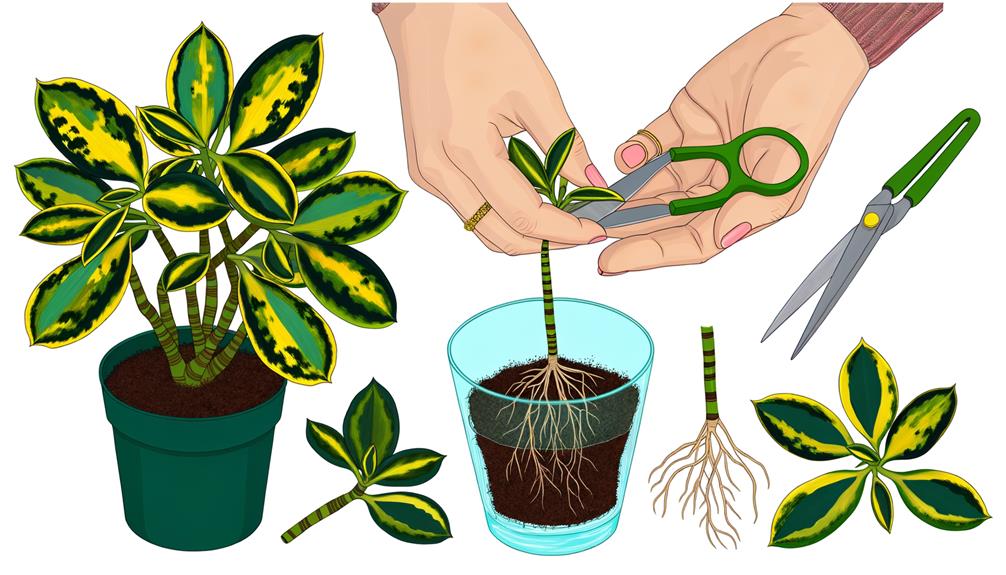
Key Takeaways
- Select a healthy parent plant free from pests and diseases.
- Make a clean cut below the node using sterilized trimming scissors.
- Remove leaves from the bottom node to avoid submersion in water.
- Place the cutting in dechlorinated water, ensuring nodes are submerged.
- Position the water container in indirect sunlight and maintain high humidity levels.
Gather Your Supplies
To successfully propagate a Painted Lady Philodendron, you will need to gather the following necessary supplies:
- Trimming scissors are important for making precise cuts on the plant to guarantee healthy propagation.
- A sanitized glass container filled with water will be used to house the cuttings during the rooting phase.
- Rooting hormone is essential as it stimulates root growth, significantly enhancing the chances of successful propagation.
- Lastly, a pot with well-draining soil is crucial to provide an appropriate growing medium once the cuttings have developed sufficient roots.
Make sure all materials are sterilized to prevent contamination and promote optimal growth conditions.
Choose a Healthy Plant
To guarantee successful propagation of the Painted Lady Philodendron, it is essential to select a strong parent plant. Begin by thoroughly inspecting the leaf condition, looking for signs of disease, discoloration, or damage.
Additionally, examine the root system to confirm it is healthy, well-developed, and free from rot or pests.
Inspect Leaf Condition
Examining the leaf condition is crucial for selecting a healthy Painted Lady Philodendron for propagation. Begin by examining the leaves for signs of discoloration, such as yellowing or browning, which may indicate nutrient deficiencies or disease.
Ensure the leaves are vibrant in color, usually displaying a mix of green and yellow hues with a mottled appearance. Check for physical damage, such as tears or holes, which could compromise the plant’s health.
Additionally, inspect the leaf surface for pests or fungal infections, noting any unusual spots or powdery residues. A robust Painted Lady Philodendron should exhibit firm, well-formed leaves with no wilting.
Selecting a plant with prime leaf condition will greatly enhance the success rate of propagation.
Check Root Health
Evaluating the root health of a Painted Lady Philodendron is a critical step in determining its suitability for propagation. Healthy roots are crucial for the successful growth of new plants.
To ensure peak root health, follow these steps:
- Inspect Root Color: Healthy roots should be white or light tan. Dark, mushy roots indicate rot and should be avoided.
- Check for Firmness: Roots should be solid to the touch. Soft or slimy roots are signs of disease or overwatering.
- Assess Root Density: A dense network of roots suggests a thriving plant. Sparse or excessively tangled roots may signal stress or poor health.
- Look for New Growth: The presence of fresh root tips indicates active growth, making the plant a better candidate for propagation.
Identify the Cutting Spot
Locate a healthy stem on the Painted Lady Philodendron that exhibits at least one node and a few leaves, making sure it is free from any signs of disease or pest infestation. This node is essential as it contains the necessary growth tissue for root development.
Carefully inspect the plant’s overall health to avoid propagating compromised material. The node should be firm to the touch and visibly distinct from the stem.
| Characteristic | Requirement |
|---|---|
| Stem Health | No signs of disease or pest infestation |
| Node Presence | At least one node visible |
| Leaf Condition | Few leaves, healthy appearance |
This detailed examination guarantees a successful propagation process, providing the new plant cutting with the best chance of thriving.
Make the Cut
To guarantee successful propagation, it is essential to select a healthy stem with at least one node and several leaves.
Utilize sharp, sterilized scissors to minimize damage and reduce the risk of infection.
Make a precise, clean cut just below the node to promote best root development.
Select Healthy Stem
Identifying a strong and lively stem is important to guarantee the successful propagation of a Painted Lady Philodendron.
Select a stem that exhibits the following characteristics:
- Vibrant Leaves: The stem should have healthy, green leaves that are free from discoloration or damage.
- Visible Nodes: Make sure that the stem has at least one node, as this is vital for root development.
- Firm Texture: Choose a stem that feels solid to the touch, indicating good internal health.
- Active Growth: Opt for a stem with new growth or buds, signifying active, robust health.
These criteria are essential to maximize the chances of successful propagation. By meticulously selecting a healthy stem, you lay the groundwork for a thriving new plant.
Use Sharp Scissors
Promoting the use of a pair of sharp, sterilized scissors is crucial for making a clean cut and minimizing damage to both the parent plant and the cutting. Dull blades can crush or tear plant tissues, leading to potential infection and slower healing.
To sterilize, soak the scissors in a solution of one part bleach to ten parts water for at least five minutes, then rinse thoroughly with clean water. Alternatively, rubbing alcohol can be used for a quicker sterilization process.
Precision in cutting is paramount; position the scissors at a 45-degree angle to facilitate best rooting. This methodical approach promotes that the philodendron cutting has the highest chance of successful propagation and reduces stress on the parent plant.
Make Clean Cut
A precise, clean cut is crucial for successful propagation, as it minimizes tissue damage and promotes ideal root development.
To achieve this, it is vital to follow a methodical approach:
- Identify the Node: Locate a healthy node on the stem, as this is where new roots will emerge.
- Angle the Cut: Make a 45-degree cut just below the node to increase the surface area for rooting.
- Sanitize Tools: Make sure your cutting instrument is sterilized to prevent the introduction of pathogens.
- Inspect the Cut: Examine the cut for smoothness; jagged edges can hinder root formation and increase susceptibility to disease.
Prepare the Cutting
To prepare the cutting, carefully select a healthy stem with at least two nodes and a few leaves to guarantee the best growth potential. Confirm the chosen stem is free from disease, pests, and damage.
Using sterilized pruning shears, make a clean cut below the second node. Remove any leaves near the base of the cutting to avoid submersion in water later. Examine the cut end for cleanliness, as jagged or crushed tissue can hinder root formation. Optionally, dip the cut end in rooting hormone to promote faster root development.
Place the prepared cutting in a shaded area for an hour to allow the cut end to callus, reducing the risk of rot during the rooting process.
Rooting in Water
To initiate the rooting process, begin by selecting healthy stem cuttings, ensuring each has at least one node and a few leaves.
Next, prepare a clean water container, preferably transparent, to facilitate monitoring root development.
Place the cuttings in the container, ensuring that the nodes are submerged while the leaves remain above the waterline.
Select Healthy Stem Cuttings
Choosing healthy stem cuttings is necessary for successful propagation, as it guarantees the new plants have the best opportunity to thrive.
To achieve ideal results, follow these steps:
- Select a Robust Parent Plant: Choose a strong Painted Lady Philodendron free from disease and pests. This increases the likelihood of strong, healthy cuttings.
- Identify Mature Stems: Opt for stems that are mature yet flexible, typically those that are neither too young nor too woody.
- Locate Nodes: Ensure each cutting has at least one node, the site where roots will develop. Nodes are essential for successful rooting.
- Use Sterilized Tools: Employ sterilized pruning shears to make clean cuts, reducing the risk of introducing pathogens to the cuttings.
Adhering to these guidelines promotes successful propagation.
Prepare Water Container
A transparent vessel filled with clean, room-temperature water is crucial for observing root development during the initial stages of propagation.
Choose a vessel made of glass or clear plastic to provide a clear view of root growth. Confirm the vessel is sterilized to prevent microbial contamination that could hinder root formation.
Fill the vessel with dechlorinated water, as chlorine can be harmful to new roots. The water level should be adequate to submerge the nodes of the stem cuttings without covering the leaves. Regularly change the water every 3-5 days to maintain oxygen levels and prevent stagnation.
Place the vessel in indirect sunlight to encourage healthy root development while avoiding potential harm from direct exposure.
Rooting in Soil
Initiating the rooting process in soil requires a well-draining potting mix to guarantee ideal moisture levels and aeration for the Painted Lady Philodendron cuttings. Make sure that the soil is sufficiently moist but not waterlogged to prevent root rot.
Follow these steps to optimize rooting conditions:
- Select a container: Choose a pot with adequate drainage holes to facilitate proper water flow.
- Prepare the soil mix: Combine equal parts of peat moss, perlite, and orchid bark to create an excellent potting medium.
- Water the soil: Moisten the potting mix thoroughly before placing the cutting to ensure even hydration.
- Insert the cutting: Gently insert the cutting into the prepared soil, making sure the node is buried at least one inch deep.
This methodical approach will enhance successful root development.
Planting the Cutting
With the cutting now prepared and rooted in soil, the next step involves planting it in its permanent container to facilitate continued growth and development. Begin by selecting a pot that offers adequate drainage, ideally with a diameter of 6-8 inches.
Fill the container with a well-aerated, nutrient-rich potting mix, ensuring it is slightly moist. Create a hole in the center of the soil, deep enough to accommodate the rooted cutting without crowding the roots. Gently place the cutting into the hole, ensuring the base is level with the soil surface.
Carefully backfill around the cutting, firming the soil lightly to eliminate air pockets. Water the newly planted cutting thoroughly, allowing excess water to drain.
Provide Proper Care
Securing ideal growth for your Painted Lady Philodendron involves providing consistent care tailored to its specific needs.
Proper care encompasses several critical factors:
- Light: Position the plant in a location where it receives bright, indirect sunlight. Avoid direct sunlight, which can scorch the leaves.
- Watering: Maintain a balanced watering schedule. The soil should be kept consistently moist but not waterlogged. Allow the top inch of soil to dry out between waterings.
- Humidity: This tropical plant thrives in high humidity. Maintain a humidity level of 60-70% using a humidifier or pebble tray with water.
- Fertilization: Apply a balanced, water-soluble fertilizer every 4-6 weeks during the growing season to secure nutrient availability.
Monitor Growth
Regularly monitoring the growth of your Painted Lady Philodendron is necessary to detect early signs of stress or disease and to maximize growth. Begin by inspecting new leaf development; healthy leaves should be vibrant and unblemished.
Measure growth rates by documenting stem elongation and leaf size periodically. Make sure the plant receives adequate, indirect light and maintain consistent moisture levels in the soil.
Check for root development in propagated cuttings by gently tugging; resistance indicates root establishment. Observe the plant for changes in coloration or wilting, which could signify nutrient deficiencies or improper watering.
Keeping detailed records of these observations will aid in identifying patterns and making necessary adjustments to cultivation practices, thereby promoting ideal plant health and growth.
Troubleshooting Common Issues
Identifying and addressing common issues in Painted Lady Philodendron cultivation involves a systematic approach to diagnosing problems such as pest infestations, nutrient imbalances, and environmental stressors. Monitoring the plant’s health is vital to guarantee prime growth.
Here are common issues and their solutions:
- Pest Infestations: Inspect regularly for signs of aphids, spider mites, and mealybugs. Use insecticidal soap or neem oil for treatment.
- Nutrient Imbalances: Symptoms like yellowing leaves may indicate a lack of nitrogen or magnesium. Apply a balanced, water-soluble fertilizer.
- Overwatering: Yellowing leaves and root rot can result from excessive moisture. Ensure well-draining soil and allow the top inch to dry before watering.
- Inadequate Lighting: Insufficient light causes leggy growth. Position the plant in bright, indirect sunlight for best results.
Conclusion
Propagation of the Painted Lady Philodendron promises abundant plant growth when performed with accuracy and patience. Proper preparation greatly enhances success, including choosing a suitable specimen and obtaining necessary supplies.
Cutting with caution and careful maintenance are essential for excellent outcomes. Diligent observation during growth and troubleshooting common issues further strengthens flourishing.
Through methodical steps and thorough examination, the process produces strong, resilient duplicates. This reinforces the gratifying effort of expanding one’s botanical collection.

